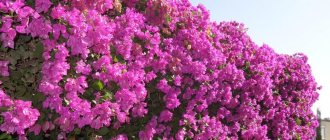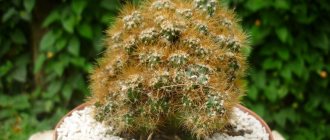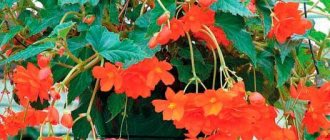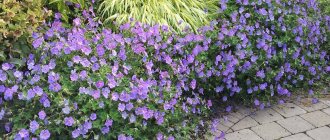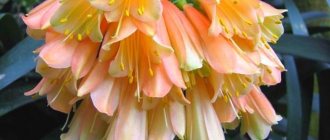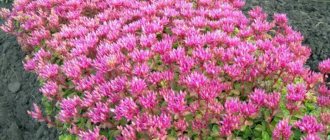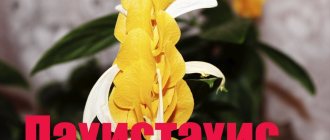Description
Geranium belongs to the perennial plants of the geranium family Pelargonium. Its origins begin in South Africa, where it is home. There are species that resemble a shrub, and there are species that resemble a herbaceous plant. At home, geranium grows no more than 1 m.
It is more common with straight stems, but there are plant species that grow as branches or creeping shoots. The leaves are wide and curly with a finger-shaped structure. Dissected leaves are considered common.
The color of the leaves is of a uniform and zonal type. In the second case, the color transition occurs from bright to darker, green color. Switching to the description of the flower, it is necessary to mention that they come in a variety of shades.
Indoor plants only lack the blue tint of flowers, but the rest are all present.
The plant produces inflorescences of different shapes. Indoor geranium flowers can be divided into two groups:
- varieties with bright and beautiful flowers;
- inexpressive colors, but fragrant and aromatic leaves.
The flowering period of Pelargonium, if the right amount of heat is maintained, can last almost a year, from spring to autumn.
Due to its composition, geranium has beneficial properties and exhibits a healing effect.
Comments
2021-07-22 23:08:57
DmitryK
the filaments of the stamens are expanded at the base. or rather, SUDDENLY expanded, as they write in many determinants, can only be understood in comparison with the stamens of G. forest or G. swamp - in which the stamens below are also expanded, but SMOOTHLY. It would be great if you could photograph the stamens specifically. Then this important sign would become more understandable.
2021-07-22 23:22:23
Sergey
Dmitry, thank you for your comments! Yes, we should, of course, look at the bases of the stamens, especially since they are indicated in the key. But, I’ll tell you honestly, I’m terribly lazy to do this! The articles have already been written. I'll add the task of photographing the bases of the stamens to my list of deficiencies, but I don't know when I'll get around to it. I hope you forgive me.
2021-07-22 23:26:17
Sergey
Although if you come across forest, meadow and marsh geraniums nearby, then you will have to do it. And it seems to me that I saw such a place in Svetlaya Polyana.
Main rules of cultivation
Growing Pelargonium at home is not at all difficult to do. In order for the bush to bloom magnificently and not gain green mass, before planting it you need to prepare a substrate of average fertility. To create drainage, expanded clay should be placed at the bottom of the pot.
Is it important to know how to water a flower? The plant needs to be watered abundantly; it is done as the top layer of soil dries. Geranium does not tolerate waterlogging of the soil. In winter, the flower is watered occasionally.
There is no need to use a sprayer to moisten the leaves, because geraniums prefer dry air. In view of this, experienced gardeners advise moving the bush to the balcony in the summer.
A houseplant consumes a large amount of light from the sun, and the sun's rays do it a lot of good, not harm. Still, on the hottest days, when the sun is at its zenith, it is worth shading the plant from active sunlight.
In the warm season, the flower feels good at almost any temperature. When winter comes, it is recommended to place the bush in a cool place with a temperature of about +15 degrees.
Amazing properties of geranium
By the way, according to astrologers, geranium plants extinguish any negative energy in the house, protect against the “evil eye” and energy vampirism.
This flower is considered a talisman; it extinguishes quarrels and protects the house from the invasion of uninvited guests. Geranium makes people kinder and more tolerant of each other.
Its aroma strengthens the nervous system and helps get rid of depression. If you place a pot of geranium in a room where a geopathogenic zone is located, the plant will neutralize all its harmful effects.
But our houses are often located in places that are not very favorable for humans. So geranium on the window will be useful to many.
Geranium can also help in love - for this you need to give geranium with scarlet flowers to the object of your tender passion. In order for the lover (or beloved) to reciprocate, the geranium must remain in the house.
Transplanting a plant
There is no need to replant geraniums often, because they are difficult to replant. For indoor care, it is recommended to replant when absolutely necessary - for example, the roots of the plant have come out of the drainage hole, the plant has become ill due to frequent watering.
The best period, which is recognized by experts for planting or replanting, is during the growing season of geranium in early spring. An important detail is that the new pot should be 2 cm larger in diameter than the previous one.
If the flowerpot is large, the green mass will actively grow, but there will be little color.
Other problems and their causes
The loss of a flower's decorative properties is not always associated with infection by diseases or pests. This may be a reaction to unsuitable conditions.
Leaves lose their decorative effect
If the top leaves of indoor pelargonium turn white, this is a sign that the room is too hot.
There are several reasons for yellowing of geranium leaves:
- lack of lighting;
- drying out of the soil or, on the contrary, excess moisture;
- soil depletion;
- The pot is too small for the plant.
Reddening of the leaves is a signal that the geranium is too cold or has been subjected to a sharp temperature change or stood in a draft. Another possible reason is exposure to direct sunlight.
The appearance of blisters on the leaves is a sign that the plant has been flooded. In this case, reduce the frequency of watering and reduce the humidity of the surrounding air.
If the tips of the leaves are dry, this is a signal that the geranium does not have enough water and needs to be watered more often.
Falling leaves are a sign of an acute lack of lighting.
Geranium doesn't bloom
More often, the reasons for the lack of buds in beautifully flowering varieties are the following shortcomings during cultivation and care:
- pot too big;
- unsuitable soil;
- lack of nutrients;
- excess nitrogen-containing fertilizers;
- untimely pruning;
- lack of light and fresh air.
To prolong flowering, it is necessary to remove the inflorescences that have begun to fade throughout the season. More recommendations on how to achieve abundant flowering of geraniums are given in the video.
If the buds appear, but dry out before they have time to bloom, this is a sign of a lack of moisture in the soil. To solve the problem, begin to water the plant more often and more abundantly, and apply potassium fertilizers.
Trimming and pinching
Caring for pelargonium at home includes pruning, which is done in the fall. A separate shoot is made shorter so that 6-7 leaves remain on it.
You will need to cut out those stems that originate not from the root, but from the axils of the leaves. Even if the bush grows again during the winter, it again needs pruning, and several buds are left on the shoots.
If desired, the cut shoots can be rooted and planted in different pots. To form a more lush, branched and profusely flowering plant, you need to pinch the sprouts above the fourth and fifth leaves. Months such as December and January are very undesirable for pruning geraniums. Propagation methods
Two popular methods for propagating pelargonium are seeds and cuttings. The first method will be more difficult. You also need to take into account that when planting hybrids, future plants may not retain their maternal hereditary properties.
To plant geranium seeds, the soil is prepared at the rate of two parts turf and one part each sand and peat. Drainage is placed at the bottom of the flowerpot, and then the main, prepared soil mixture.
The seeds are taken and evenly distributed over the surface of the soil with a gap of 2 cm between each other, then they are covered with soil. Next, the soil is moistened using a sprayer. Until the seed germinates, the pot must be covered with film or glass to create a constant temperature of +20 degrees.
At this time, you need to do ventilation from time to time. Until two true leaves form, the flower should be watered periodically. After the plant is cut to 6 leaves, all shoots can be planted in different flowerpots;
Propagation by cuttings. This is an easier way. This method can be used at any time of the year. But in the spring, the emergence of roots occurs very actively and this time is more suitable for this.
The cuttings disconnected from the plant are left to lie in the air for 3 hours. Then it needs to be buried in the soil or coarse sand. It is not covered from above. After the roots have formed, it is transplanted into a flowerpot.
The following transplantation method is often used - a leaf from pelargonium is cut off and placed in water. When roots appear, the sprout is planted in a pot.
Geranium: home care
How to care for geraniums? The plant does not require special care, but when growing it you should pay attention to a number of rules. Compliance with them will make caring for geraniums easier and will allow the plant to live in the house for a long time.
Here's what to remember when growing geraniums in a pot:
- The plant loves light. It needs light for at least 12 hours a day. Therefore, in summer it must be placed on the sunny side, periodically turning the pot. In winter, it is worth giving the plant additional lighting.
- Geraniums are flowers that need fresh air, but they do not tolerate drafts. Therefore, in the summer, when ventilating the room, make sure that the plants are not near air currents.
- Indoor geranium loves moisture. It should be watered with clean filtered water or water that has stood for at least 24 hours. Moreover, with the onset of warm weather (spring–autumn), it is watered as soon as the soil in the pot becomes dry. If there is water left on the tray after watering, it must be drained. Remember: excess moisture is harmful to the plant.
- Caring for geraniums at home in winter does not involve watering. But due to the operation of heating devices or central heating radiators, the leaves may dry out. Therefore, they should be sprayed with warm water.
- Homemade geranium flowers feel normal at normal room temperature and normal air humidity for the room. The temperature regime that is comfortable for the plant is from 15 to 25 °C.
- I recommend feeding the plant with liquid fertilizers every 15 days, and with the onset of autumn, cutting off excess shoots.
- The plant develops normally in universal soil.
Geraniums, which must be cared for regularly, can bloom throughout the year. My experience and the practice of my colleagues only confirm this.
Geranium: Pixabay
Diseases and pests
Geranium has good disease resistance. She can still get sick and often this is due to improper care. Sometimes it happens that the base of the stem of a young bush turns black - this is black rot. This plant disease cannot be treated. Therefore, the affected plant is burned and the soil is changed to another.
To prevent the appearance of gray and black rot on the roots, do not let the liquid in the pot stagnate. Pests that may appear include mites, aphids and whiteflies. When aphids or mites appear on a flower, then you need to prepare an infusion of tobacco, chamomile with green soap and wipe the plant and leaves with it, including the back side.
After 3 hours, the bush should be rinsed with water. To rid geraniums of whiteflies, the following drugs are used alternately: Actellik, Confidor, Bison, Fufanon. After all, it is not easy to destroy larvae and adult whiteflies.
Types of pelargonium
There are quite a lot of crop varieties. Breeders regularly create new hybrids. One plant can be distinguished from another by the shape of its leaves or flowers, as well as its color. Varieties of geraniums with white and two-color petals, variegated plants, and dwarf bushes have been developed.
Among all the existing diversity, some types of geranium have gained great popularity. The following can be distinguished:
- grandiflora;
- ivy-leaved;
- peony-shaped;
- unique;
- zonal;
- fragrant;
- angel;
- succulent.
Peony geranium was bred artificially. It was the result of numerous experiments by specialists. They were able to achieve the amazing decorative properties of the flower - lush and large, resembling a peony.
Peony inflorescences
Another popular, exquisitely flowering variety is Pelargonium grandiflora. It has a compact bush and lush flowers.
On window sills you can most often find zonal pelargonium. It blooms profusely, is resistant to diseases and pests, and is unpretentious. The flowers of this plant can be double, semi-double or regular.
For convenience, flower growers combine a huge variety of pelargoniums into four groups: fragrant, zonal, large-flowered or noble, ivy-leaved.
Fragrant (Pelargonium roseum)
The flowers of fragrant pelargonium are very bright, but unsightly. They mostly look like pink or pinkish-purple umbrellas. The bush itself is highly branched and quite tall. The stems are woody in the lower part, and herbaceous in the upper part.
This pelargonium is the flower with the most pronounced scent. The aroma of the plant is pleasant, reminiscent of lemon or mint. Its source is the hairs that cover the leaves on both sides.
Sometimes you can find geraniums that give off the scent of nutmeg, apple or orange. Essential and aromatic substances are extracted from the leaves, which are actively used in cooking. However, it is not recommended to eat the leaves directly.
Zonal (Pelargonium zonale)
The zonal variety is distinguished by a developed and upright growing stem. For this feature they are also called “standing”. A characteristic feature is dark circles on the leaves; they seem to divide the plate into several zones. The leaf shape is round or kidney-shaped.
Zonal geranium can have flowers, both simple and double. They are not very big, but they look nice. Collected in inflorescences of white, red or pale pink. It is this pelargonium that is known to almost everyone.
Zonal pink
This group is divided into subgroups:
- Rosaceae - flowers resemble roses;
- tulip-shaped - look like closed tulip buds;
- carnation flowers - the flowers have carved petals, which is why they resemble a garden variety;
- star-shaped - with sharp flowers and leaves;
- cactiformes - a very rare subgroup in which the flower petals are rolled up into a tube;
- “deacons” - the culture is distinguished by its compact shape and lush flowering.
Large-flowered (Pelargonium grandiflorum)
The most prominent plants were included in the large-flowered group. The most spectacular representatives include English pelargonium (royal geranium) with flowers up to 5 cm. It is a herbaceous plant with a maximum height of 40 centimeters. The slightly branched stem is strewn with leaves with finely toothed edges that lack a brown girdle.
Noble royal pelargonium
Noble varieties are very popular for their beauty. The shades of flowers can be different - from white to dark red with a purple tint. The degree of terry is also varied. The fluffiest ones are similar to peony geranium, but they are different species.
Ivy-leaved or ampelous
Ivy-leaved pelargonium is used to decorate balconies or loggias. Hanging shoots look gorgeous in hanging flowerpots. The leaves of geranium are hard and dense, reminiscent of ivy. This is the reason for the second name of the culture.
Composition of pelargoniums
Flowers of ampelous pelargonium are collected in several pieces and can take the form of rosettes. Special varieties have been bred in which the leaves have a white border and the flowers are variegated.
Photo of indoor plant Geranium
LiveInternetLiveInternet
Pelargonium (Geranium)
.
Surely everyone is well aware of the red geranium
in a pot - the favorite of our grandmothers. It must be said that this generally recognized attribute of bourgeois comfort still decorates the window sills of not only residents of our country, but also Europeans. But the correct name of this flower is pelargonium, and anyone can envy the variety of its modern varieties and their colors. In addition, it is now customary to grow it not on the windowsill, but in the garden or on the balcony. Latin name: Pelargonium
In greenhouses, winter gardens, and on our windowsills, various varieties of geranium (or pelargonium) bloom: ivy-shaped, large-flowered English, fragrant with carved leaves, a variety with the scent of nutmeg or orange, apple, and others. I especially like the small, ampel-shaped bushes with very beautiful star-shaped flowers and succulent ivy-shaped leaves.
In addition to its beauty, geranium creates a positive aura around itself. It is easy to care for, it is rarely susceptible to disease, requires moderate watering and a not too nutritious soil mixture, is resistant to drought, and has high vitality. However, certain rules for growing and caring for these charming plants should be followed.
It is not surprising that pelargoniums are so loved all over the world. They are easy to care for, easy to propagate, and bloom for a long time with large and colorful inflorescences.
In winter, the pot with geranium should be kept in a cool place at a temperature of 8-10C, in no case allowing overwatering or waterlogging of the soil in autumn and winter. Pelargonium is most often propagated by cuttings (shoots), less often by seeds. Cuttings are carried out in February-March or in the summer, in June-July.
Bouquets of geraniums bloom until late autumn. In winter, with a lack of light and high temperature, the bushes stretch out, lose their decorative effect, the stem becomes bare and the plant stops flowering. In the spring, transplantation is carried out; spraying the leaves with water is unacceptable. With the onset of warm, sunny days, pots of geraniums are taken out into the fresh air, choosing a well-lit place. From now on, she will again delight us with her elegant bouquets, filling the house with aroma (which, by the way, repels pests), bringing peace and tranquility.
History of a flower
Geranium and pelargonium belong to the Geranium family. But Gkran is a resident of the middle zone, and most varieties of pelargonium come from the savannahs of South Africa. Therefore, this flower loves the sun and easily tolerates lack of moisture. Both the names "geranium" and "pelargonium" come from the Greek language. The first of them is translated as “stork”, and the second as “crane”, since the shape of the fruits of these plants resembles the beak of a stork.
In its current “cultivated” form, this flower first appeared in Holland in the 16th century. In Europe, pelargoniums appeared at the end of the 17th - beginning of the 18th centuries. But if then it was just an African exotic, then in the 18th and 19th centuries pelargonium became one of the most popular flowers, with about a thousand varieties. It gained particular popularity in the UK, becoming a symbol of the Victorian style of “good old England”.
In the last century, a lot of breeding work was carried out to develop numerous hybrids and varieties. Variegated plants were obtained, dwarf forms, varieties with white and two-color, as well as double flowers were bred.
What is the reason for the new rise in popularity of this flower that has occurred in recent years?
The fact is that until recently, pelargonium could only be propagated vegetatively, that is, by cuttings. And this process is quite labor-intensive and does not allow you to obtain many plants at the same time. And only in the 80-90s, with the advent of new generation hybrids (F1), did it finally become possible to propagate varietal pelargonium by seeds. This has led to the fact that she is now experiencing a new “finest hour”.
Pelargonium varieties
In total, there are 6 groups of pelargoniums:
- /www.myflora.com.ua/templates/myflora/images/strelka.gif" target="_blank">https://www.myflora.com.ua/templates/myflora/images/strelka.gif); line-height: 13px; padding-left: 14px; padding-top: 2px; background-position: 0px 4px; background-repeat: no-repeat no-repeat; “> zonal (garden);
- /www.myflora.com.ua/templates/myflora/images/strelka.gif" target="_blank">https://www.myflora.com.ua/templates/myflora/images/strelka.gif); line-height: 13px; padding-left: 14px; padding-top: 2px; background-position: 0px 4px; background-repeat: no-repeat no-repeat; “> ivy-leaved (ampeloid);
- /www.myflora.com.ua/templates/myflora/images/strelka.gif" target="_blank">https://www.myflora.com.ua/templates/myflora/images/strelka.gif); line-height: 13px; padding-left: 14px; padding-top: 2px; background-position: 0px 4px; background-repeat: no-repeat no-repeat; «> English grandiflora (royal or domestic);
- /www.myflora.com.ua/templates/myflora/images/strelka.gif" target="_blank">https://www.myflora.com.ua/templates/myflora/images/strelka.gif); line-height: 13px; padding-left: 14px; padding-top: 2px; background-position: 0px 4px; background-repeat: no-repeat no-repeat; "> variegated;
- /www.myflora.com.ua/templates/myflora/images/strelka.gif" target="_blank">https://www.myflora.com.ua/templates/myflora/images/strelka.gif); line-height: 13px; padding-left: 14px; padding-top: 2px; background-position: 0px 4px; background-repeat: no-repeat no-repeat; "> fragrant;
- /www.myflora.com.ua/templates/myflora/images/strelka.gif" target="_blank">https://www.myflora.com.ua/templates/myflora/images/strelka.gif); line-height: 13px; padding-left: 14px; padding-top: 2px; background-position: 0px 4px; background-repeat: no-repeat no-repeat; "> succulents.
The last three groups are of interest mainly because of their leaves; the large-flowered one is grown only indoors, but the zonal and ivy-leaved pelargoniums are excellent plants for the garden and balcony, which can now be propagated by seeds. I'll tell you more about them. Pelargonium
zonalis
gets its name from its leaves with horseshoe-shaped stripes (“zones”). Zonal pelargonium is native to South Africa. Nowadays, many varieties have been developed in which the leaf pattern itself is more attractive than the flowers. The flowers, varied in color and number of petals, are collected in numerous hemispherical umbrellas on long leafless peduncles. Flowers come in almost all shades (except pure blue and pure yellow), and even two-color, simple or double. There are variegated forms, suitable mainly for flower beds. Plant height is from 25 to 50 cm.
This plant can be planted both in a flower bed and in balcony boxes or containers. In this case, with the onset of the cold autumn months, you can easily remove the plants into the house.
Geranium zonalis
has phytocidal properties.
Its leaves have a peculiar smell, however, not pleasant for every person. Old geraniums can be rejuvenated by cutting off the apical shoot for rooting. Pelargonium ivy-leaved
.
This variety of pelargonium is very unpretentious, very quickly forms many shoots up to 90 cm long with leaves resembling ivy leaves, decorated with racemose inflorescences of various colors: not only red and pink, but also snow-white and black-violet. Growing ivy-leaved geraniums in baskets and boxes is considered ideal.
What can you buy in our stores?
Unfortunately, so far our stores do not please us with a special abundance of seeds and variety of varieties. You will have to look for pelargonium seeds.
Seeds of ivy-leaved pelargonium are, in general, extremely rare. Basically, these are imported seeds (Italian, German or English). Most often you can find a mixture of different colors of Summer Showers. But even then, with a fair amount of luck.
With zonal pelargonium everything is better. The most common are bags of the Dutch company Sem with a mixture of “Multibloom” (white, red, pink, lilac and salmon flowers) or separately with a variety with bright red flowers. The same Multibloom mixture can also be found in the NK Profi series. In the same series, seeds of the “Star of the Moscow Region” variety with soft pink flowers with a darker center have recently appeared. In addition, the NK Corporation also produces a mixture of varieties called “Early Universal”.
Unfortunately, this is where the list can end for now. Other seeds are still extremely rare.
So, all of the above inspired you and you asked a completely logical question: what needs to be done to make all this beauty appear on my site or balcony. I can offer you three options.
Option one
The simplest thing you can do is to find pelargonium seeds in the store and grow your future flowers from them. However, this option also has its disadvantages. Firstly, the seeds must be sown no later than the end of February, otherwise the pelargonium will bloom only in the fall. So, hurry up! Keep in mind that it takes about 5 months from germination to flowering. Secondly, it is not always possible to find seeds in the store. To do this, it is better to go to a large garden center. Thirdly, pelargonium seeds germinate quite slowly (up to 20 days) and it’s bad that novice gardeners may be disappointed.
Option two
If you or (more likely) your grandmother has a large pelargonium bush living on her window for a long time, you can take cuttings from it. To do this, cut off several apical shoots with 4-5 leaves, remove the lower two leaves and place the cuttings in water. You can also dip the cuttings in a special powder that stimulates the formation of roots (for example, in “Kornevin”), and place them in a mixture of peat or garden soil with sand. Cuttings should root at room temperature and in good light. Using cuttings, you can get an average of 5 to 15 new ones from one adult plant. By the way, such pruning only benefits the old bush.
Option three
Finally, in the spring (April-May) you can buy ready-made pelargonium seedlings. In theory, it is sold in garden centers and flower growers. But in practice it is not always possible to find it. So, the first two options are more reliable.
Secrets to successfully growing pelargoniums:
- /www.myflora.com.ua/templates/myflora/images/strelka.gif" target="_blank">https://www.myflora.com.ua/templates/myflora/images/strelka.gif); line-height: 13px; padding-left: 14px; padding-top: 2px; background-position: 0px 4px; background-repeat: no-repeat no-repeat; “> Pelargonium prefers sunny places, but will also tolerate shading.
- /www.myflora.com.ua/templates/myflora/images/strelka.gif" target="_blank">https://www.myflora.com.ua/templates/myflora/images/strelka.gif); line-height: 13px; padding-left: 14px; padding-top: 2px; background-position: 0px 4px; background-repeat: no-repeat no-repeat; “> Pelargonium is thermophilic, but will survive very light frost.
- /www.myflora.com.ua/templates/myflora/images/strelka.gif" target="_blank">https://www.myflora.com.ua/templates/myflora/images/strelka.gif); line-height: 13px; padding-left: 14px; padding-top: 2px; background-position: 0px 4px; background-repeat: no-repeat no-repeat; “> Pelargonium should be watered abundantly in summer and moderately in winter.
- /www.myflora.com.ua/templates/myflora/images/strelka.gif" target="_blank">https://www.myflora.com.ua/templates/myflora/images/strelka.gif); line-height: 13px; padding-left: 14px; padding-top: 2px; background-position: 0px 4px; background-repeat: no-repeat no-repeat; “> It is advisable to provide pelargonium with access to fresh air and low humidity.
- /www.myflora.com.ua/templates/myflora/images/strelka.gif" target="_blank">https://www.myflora.com.ua/templates/myflora/images/strelka.gif); line-height: 13px; padding-left: 14px; padding-top: 2px; background-position: 0px 4px; background-repeat: no-repeat no-repeat; “> The plant prefers fertile, well-drained soil. The soil mixture consists of equal parts of turf soil (or compost soil), humus, peat and sand.
- /www.myflora.com.ua/templates/myflora/images/strelka.gif" target="_blank">https://www.myflora.com.ua/templates/myflora/images/strelka.gif); line-height: 13px; padding-left: 14px; padding-top: 2px; background-position: 0px 4px; background-repeat: no-repeat no-repeat; “> From spring to autumn, it is necessary to apply flower fertilizer weekly, to which it is advisable to add microelements. You can find specialized liquid fertilizer “Pelargovit” on sale.
- /www.myflora.com.ua/templates/myflora/images/strelka.gif" target="_blank">https://www.myflora.com.ua/templates/myflora/images/strelka.gif); line-height: 13px; padding-left: 14px; padding-top: 2px; background-position: 0px 4px; background-repeat: no-repeat no-repeat; “> To form neat bushes, it is recommended to pinch to enhance branching.
- /www.myflora.com.ua/templates/myflora/images/strelka.gif" target="_blank">https://www.myflora.com.ua/templates/myflora/images/strelka.gif); line-height: 13px; padding-left: 14px; padding-top: 2px; background-position: 0px 4px; background-repeat: no-repeat no-repeat; “> Withered flowers must be removed.
Location
light, sunny, ventilated, in summer the plant is taken out into the fresh air, but in a shady place. Pelargoniums are kept in winter at a temperature of 10-15 degrees.
Lighting
Bright light
Watering
in summer - abundant, in winter - limited. All pelargoniums have the ability to accumulate water, so they are considered dry-resistant.
Air humidity
Moderate
Care
“Geranium (or rather, pelargonium) loves calcium, so during the period of active growth it is useful to add milk to the water for watering geraniums (25 ml for each plant). Geraniums respond positively to mineral and organic fertilizing in the spring and summer. To form a bush, pruning or pinching should be done, although geraniums do not like frequent and strong pruning.
Reproduction
All geraniums are easily propagated by cuttings throughout the year; the most favorable time for cuttings is February-March and July-August. It is better to renew geraniums by cutting off the apical shoot for rooting. When cutting, the cut cutting is first slightly withered and planted in a substrate, kept dry (watered rarely and not sprayed).
Transfer
Young geraniums must be replanted annually. This is done in the spring before growth begins. The container for the roots should be small, otherwise leafy shoots will develop strongly, but the plant will not bloom. A mixture of turf, leaf, humus soil and sand (2:2:2:1) is suitable for cultivating geraniums.
Possible difficulties
Errors in care can be determined by the appearance of the plant.
- /www.myflora.com.ua/templates/myflora/images/strelka.gif" target="_blank">https://www.myflora.com.ua/templates/myflora/images/strelka.gif); line-height: 13px; padding-left: 14px; padding-top: 2px; background-position: 0px 4px; background-repeat: no-repeat no-repeat; "> Yellowing lower leaves.
Reason: if the leaves remain elastic or only their edges dry out, the cause is a lack of moisture. If the leaves are limp or rotting, it is due to excess moisture. In both cases, leaves may fall off - /www.myflora.com.ua/templates/myflora/images/strelka.gif" target="_blank">https://www.myflora.com.ua/templates/myflora/images/strelka.gif); line-height: 13px; padding-left: 14px; padding-top: 2px; background-position: 0px 4px; background-repeat: no-repeat no-repeat; "> Redness of the edges of the leaves.
Cause: Temperature too low. Move the pot away from the window on frosty nights. - /www.myflora.com.ua/templates/myflora/images/strelka.gif" target="_blank">https://www.myflora.com.ua/templates/myflora/images/strelka.gif); line-height: 13px; padding-left: 14px; padding-top: 2px; background-position: 0px 4px; background-repeat: no-repeat no-repeat; “> Darkening of the base of the stem.
Causes: blackleg disease. The diseased plant is destroyed. In the future, use sterilized soil and avoid overmoistening it. - /www.myflora.com.ua/templates/myflora/images/strelka.gif" target="_blank">https://www.myflora.com.ua/templates/myflora/images/strelka.gif); line-height: 13px; padding-left: 14px; padding-top: 2px; background-position: 0px 4px; background-repeat: no-repeat no-repeat; "> Bare stems;
falling of the lower leaves. Reason: lack of light - pelargoniums are light-loving. - /www.myflora.com.ua/templates/myflora/images/strelka.gif" target="_blank">https://www.myflora.com.ua/templates/myflora/images/strelka.gif); line-height: 13px; padding-left: 14px; padding-top: 2px; background-position: 0px 4px; background-repeat: no-repeat no-repeat; “> Watery soft pads on the leaves.
Reason: edema is a non-contagious disease associated with waterlogging of the soil. Reduce watering. - /www.myflora.com.ua/templates/myflora/images/strelka.gif" target="_blank">https://www.myflora.com.ua/templates/myflora/images/strelka.gif); line-height: 13px; padding-left: 14px; padding-top: 2px; background-position: 0px 4px; background-repeat: no-repeat no-repeat; "> Gray mold on the leaves.
Cause: gray mold caused by the fungus Botrytis; occurs when the soil becomes waterlogged. Contagious disease - remove affected leaves, treat with a systemic fungicide, better ventilate the room and reduce watering. - /www.myflora.com.ua/templates/myflora/images/strelka.gif" target="_blank">https://www.myflora.com.ua/templates/myflora/images/strelka.gif); line-height: 13px; padding-left: 14px; padding-top: 2px; background-position: 0px 4px; background-repeat: no-repeat no-repeat; “> Lack of flowers on domestic pelargonium.
Cause: If the plant looks healthy, the likely cause is too warm air in winter.
Beneficial features
According to ancient beliefs, geranium (pelargonium) with pink flowers attracts love, it is used in love magic, but white geranium increases fertility. True, what you need to do with these flowers for this (smell, eat or just look at them) is not said there.
If you put pelargonium leaves in jars of jam, it will not become moldy.
Pelargonium oil is widely used in aromatherapy. It has a calming and mood-improving effect on the psyche. It can even cope with depression. In addition, it is used to treat burns, ulcers, wounds, dermatitis and eczema. It also helps with problems during menopause and relieves PMS.
Some types of pelargonium are widely used as insecticidal plants.
Botanical passport of the plant, benefits and application
Geranium is translated from the Greek “geranion” or “geranios” meaning “crane”. In the USA and Great Britain the plant is called “crane bird” (Cranesbill), in Germany – “stork nose” (Storchschnäbel). The flower belongs to the genus of the Geranium family; there are more than 300 species in the world; only forty grow in Russia. The plant reproduces by seeds and vegetatively, the flowering period is from twenty to forty days. Blood-red geranium has the most healing properties.
Geranium roots contain phenols, buds, flowers and leaves - tannins, carbohydrates, vitamins, flavonoids, essential oils. Geranium is used as an astringent for intestinal disorders, women's diseases, neuralgia, lupus, respiratory infections, rheumatism, epilepsy, and insomnia.
Traditional methods of treatment with geranium
Geranium is a real home doctor, because it provides invaluable help for many diseases, restoring your health without pills. The simplest way to get rid of a runny nose is to soak cotton wool in the fresh juice of the plant’s leaves and periodically inhale this bright smell for several minutes. Young leaves of indoor flowers help with intestinal disorders and kidney diseases, as they have strong anti-inflammatory and bactericidal properties. To get rid of diarrhea, just wash a few fresh leaves and simply chew them.
When a nervous tic occurs or an attack of intercostal neuralgia occurs, young geranium leaves are placed on a linen rag and bandaged with greenery to the sore spot, tied on top with a warm scarf or handkerchief. Change the bandage to a fresh one every thirty minutes until the pain completely disappears. This usually happens within an hour or two.
Geranium infusion is very effective for salt deposition and osteochondrosis. To do this, take twenty grams of geranium flowers and leaves, leave in a water bath for ten to fifteen minutes, cool, filter, and dilute with water to 200 ml. Take two tablespoons of infusion 2-3 times a day.
Cosmetic ice is prepared from geranium flowers: fresh inflorescences are frozen by filling them with clean water in ice molds. Recommended for smoothing wrinkles and refreshing complexion for women forty years and older. For toothache, just put a young geranium leaf on your cheek.
The fresh juice of the plant is used for various ear diseases. Often in folk medicine a simple method of treatment is used: a clean geranium leaf is rolled up into a tube and placed in the sore ear overnight. For bites from snakes, scorpions and other insects, infusions, decoctions and preparations of geranium help well. Corns and calluses are effectively reduced by poultices made from the fresh herb of the plant.
An infusion of geranium flowers is prepared and added to the bath to relieve itching in skin diseases, eczema, scabies, and ulcers. An infusion of roots is used internally for cardiovascular diseases and to lower blood pressure. This decoction is used externally as a lotion for various types of ulcers, carbuncles, boils, cellulitis, and abscesses.
This is interesting
In the old fairy tale by Samuil Marshak (1887-1964) “The Cat’s House” there is an interesting dialogue between a goat and a goat: “Listen, fool, stop eating the owner’s geranium / - Try it, it’s very tasty, like chewing a cabbage leaf.” This cheerful exchange of funny characters reflects the true essence of geranium - nature created the flower not only for beauty, it is beneficial, heals and restores strength.
Geranium helps keep pets clean and free from ticks. To do this, just place a piece of a plant leaf in the ear of a cat or dog. If you rub your pet's fur with fresh geranium juice, it will always be shiny and thick. The procedure can be carried out no more than once a quarter. An amazing plant, a home doctor lives next door to us - he will cure pain and bring beauty to the house. https://www.myflora.com.ua/?option=com_content&task=view&id=418&Itemid=1 AND MORE HERE - https: //www.botanichka.ru/blog/2010/02/22/pelargonium/
How to care for geraniums in a pot after purchase
You can buy pelargonium at any flower shop. It should be borne in mind that after purchase a flower may feel stressed, to reduce which the following care tips should be followed:
- In the first few days, pelargonium is not watered. The pot with it should be placed in a small shade so that it can recover after changing its habitat;
- 2 days after purchase you need to transplant the pelargonium into a new substrate. You need to use light soil intended for violets;
- Water pelargonium moderately only after the top layer of soil has dried.
If you take proper care, the flower will quickly adapt to the new place of growth and will delight you with abundant flowering.
